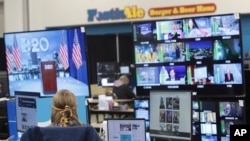Political conventions have always been considered a four-day television commercial for political parties and their presidential candidates. The 2020 Democratic National Convention is taking that to a new level with its virtual convention.
Forced by the coronavirus pandemic to rethink how to stage a convention, Democrats changed what was once a slickly produced live event with politicians speaking from a podium in an arena filled with people. Instead, it appears they are bringing the convention to the people, using short videos to create an atmosphere of watching a social media feed.
Vanessa Beasley, communications professor at Vanderbilt University, said eliminating the crowded arena created an aura of intimacy for viewers.
“I think [Democrats] made some really strategic decisions about what it meant to go virtual and television as a particular medium, but also thinking about the way the rest of the media would pick up particular clips and sound bites to circulate on social media,” Beasley said.
On the opening night Monday, viewers couldn’t help noticing the difference right from the start, with dozens of choir members singing the national anthem from their homes across the country on what appeared to be a giant Zoom call.
And while some of the video was grainy and awkward and not the quality television networks might normally use, Beasley called it “authentic” because we are now used to seeing it on computers and smartphones.
Shorter speeches
Conventions are also a place for the political parties to showcase their big-name stars.
Former presidents, previous nominees, congressional leaders and state governors all lobby for prominent speaking roles. Keynote speeches from past conventions gave a national platform for future Presidents Barack Obama and Bill Clinton.
This year, those speeches are being limited. Clinton, whose convention speeches have been legendarily long, was limited to 5 minutes Tuesday night. Other high-profile Democrats are getting less time. Beasley said part of the reason is that there isn't a live audience to play to.
“When you're writing a speech for a typical political convention … you have to actually have very few words in the speech, because if it goes well, you need to leave a lot of time for the audience to respond,” she said.
Instead of assigning the keynote speech to just one speaker, Democrats used 17 so-called rising stars of the party to deliver the keynote message in a video mash-up that caught the eye, if not the ear, of viewers.
Roll call
One of the hallmarks of any convention is the roll call vote of the states to officially select the party’s presidential nominee. It used to be that the roll call provided drama and suspense when no candidate entered the convention with enough delegates to clinch the nomination. While that hasn’t happened in more than 40 years, the roll call still gives viewers a window into the process.
Instead of a state delegation leader on the convention floor shouting over a noisy arena to tout the state and its delegate count, viewers, who have mostly been homebound during the pandemic, were treated to a virtual trip across the country.
Delegation leaders were shown in their home states, usually at recognizable locations, to explain why their states are so great and deliver the vote counts. Instead of the same old backdrop in a convention hall, viewers were treated to some new panorama every minute.
Pros and cons
Democrats are also taking advantage of technology that allows people to make their own videos and send them in. They are being dropped in at strategic spots in the program.
Lara Brown, director of George Washington University’s Graduate School for Political Management, said the advantage to a virtual convention is the ability to engage more people.
“One of the real advantages of a virtual convention is that you could bring together partisans in small groups around the country and essentially have a nationwide meetup,” Brown said.
A big concern is whether the virtual convention can generate the kind of enthusiasm that a live convention can bring. So far, there has been a significant decline in television viewers.
According to Nielsen Media Research, 18.6 million people watched Monday’s convention coverage, down 27% from the first night of the 2016 Democratic National Convention.
The Biden campaign said more than 10 million additional people watched live internet streams of the convention. However, ratings for internet streaming are not as reliable as TV ratings.
Jay Cost of the American Enterprise Institute said he thought the most important thing for the conventions was to get the party’s nominee before a large cheering crowd to create the impression of widespread adoration and support.
“I'm going to be really interested to see the vibe, feel of these acceptance speeches without the usual hoopla and whether or not they work,” Cost said.
VOA's Patsy Widakuswara contributed to this report.




